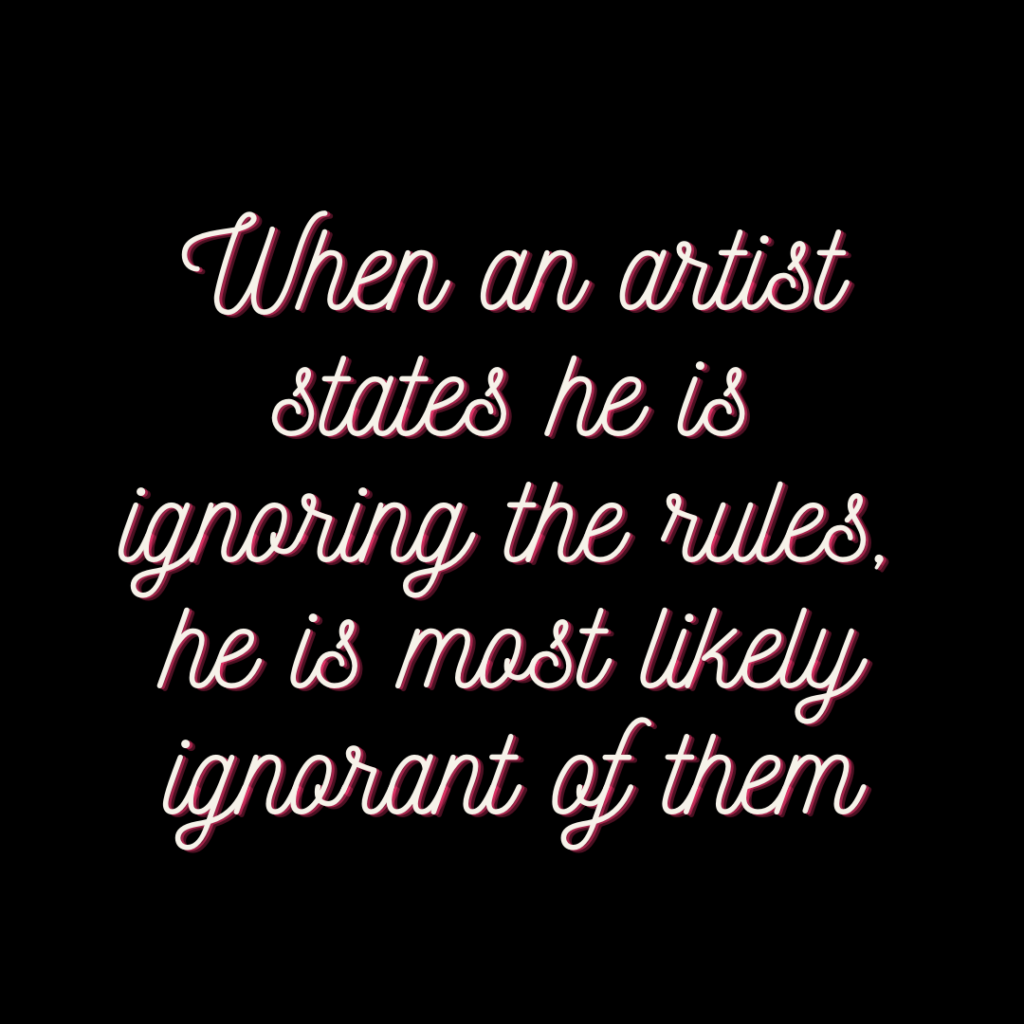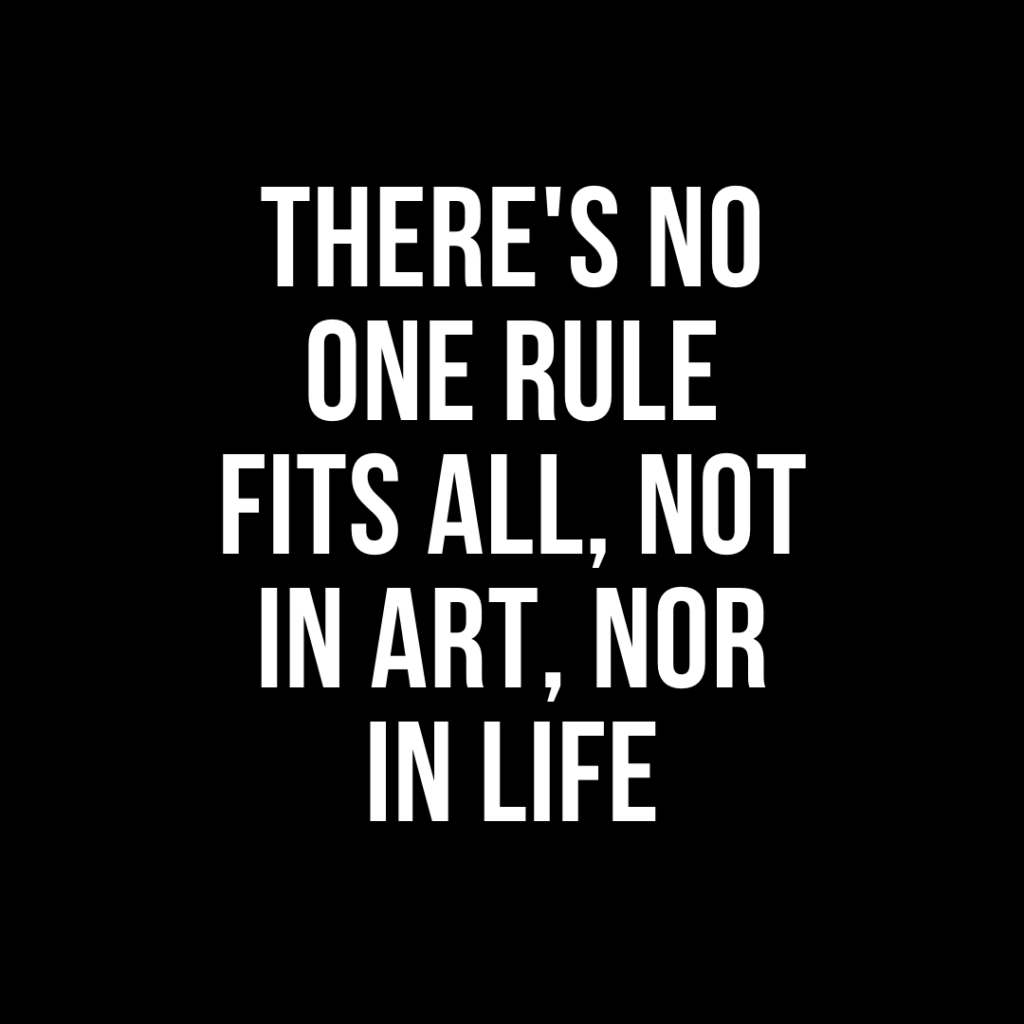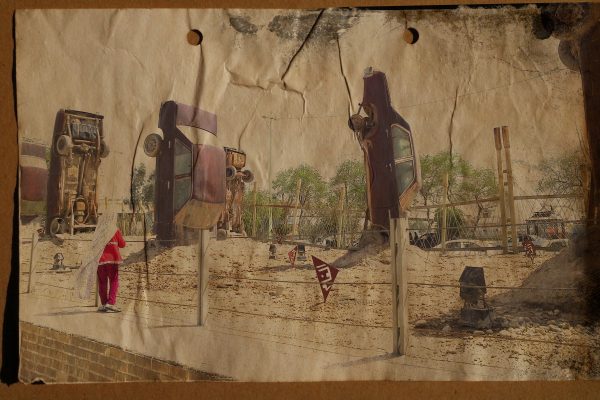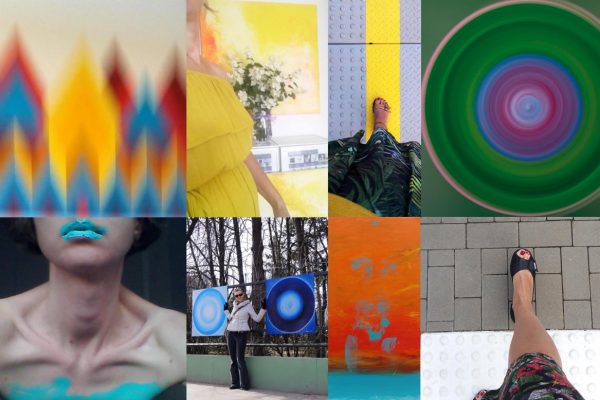Art has (NO) rules. What a controversial subject raising so many questions …Can art be defined? Can we put something that comes from the need of soul and heart into frame or box of rules? On the other hand, can we break rules if we don’t know them? Who sets the rules and tell others what is right or wrong, beautiful or not, worth a lot of money or not? What is more important, the rules that are followed every step or the story or message the artist want to deliver through art? Should artists follow the rules, or not? We have asked few artists, art historian, fashion designer, painters, journalist … to tell us what they think and what is their approach to rules when they create or look at the creation. Are rules necessity? Or not?

‘Art is a set of processes aimed at a result that can endorse a “technical” value as well as an “aesthetic” value. But, can art do without rules? The art of the architect synthesizing geometry with mathematics is not the same as that of the artist who devotes himself to the fine arts, a selfless art which covets visual beauty. It is this last meaning that interests us here, because one cannot imagine how art in the “technical” sense could ignore the use of rules. For its part, the rule designates a standard that prescribes any form of imagination and artistic freedom. Art presupposes mastery of the techniques taught in art schools, subject to rules which govern all artistic creation and which turns out to be mimetic learning. However, there are autodidacts capable of going beyond the know-how of artists from the Fine Arts school and who have never been constrained to any academic artistic dogma. We can see in all these antinomies that art is a discipline with subjective meanings that should please without following any course of action or regulations.’
Patrick QUENUM – Art Historian, writer
© Patrick QUENUM (All rights reserved)
linkedin.com/in/patrick-quenum-2590711b1
Joanna Ciechanowska – Director of the gallery at Polish Social and Cultural Association (Polski Ośrodek Społeczno-Kulturalny) That’s a lie. Art has its own rules and lucky are the ones who know what they are. And who defines them. Art galleries – the big, public founded ones or the small commercial ones? The art fairs? The auction houses? All have their own rules, mostly based on money. Or, politics of the time. Or constricted rules of the establishment. In the meantime, poor young artists are taught to shock, to bring the audience at first, to attract the publicity and once they are in the public eye, they can do what they like. Without naming the famous artists now, we can see how it’s done. The famous Duchamp’s urinal idea is still relentlessly copied today. Some others, paint dogs and cats according to their own rules. Which bring me to ’the rule of the artist’. What are they? I think, it’s the dialogue of the painting with the viewer, the narrow line between the description and the intrigue, between the narrative and the edge of the boundary where the real art begins its own life. Myself, I can confess, I have only one rule: Never compromise’

Edward Kiersh – Journalist, writer ‘Breaking Free. Imagine Leonardo Da Vinci and Salvador Dali meeting at an Art Deco cafe on the Boulevard St. Germain, discussing their different versions of The Last Supper—a painting imbued with their two competing theories of artistic expression. A transcendent, Renaissance genius, Da Vinci would insist art was science, “the daughter of Nature,” and that his paintings were governed by fixed laws. Daringly willing to explore sexuality, mysticism, and the subconscious—subjects defying preconceived notions, demanding the full expanse of his imagination—Dali couldn’t have flourished in a claustrophobic world limited by immutable boundaries. He needed absolute freedom to experiment, to probe dreams, labyrinths, and the metaphysical. His works speak to us because they were sparked by a boundless sensibility and provocation, an urge to be free. The rebellious Kandinsky, Maria Abramovic, James Joyce, Fellini, Frida Kahlo, Philip Glass and rock-n-roll pioneers were all “notorious” rule breakers, fighting against the conventional. They all believed that their imagination would lead to inspiration, allow them to break away from outdated thinking, and to discover vast new dimensions of creativity. They were proven right, to an extent. By violating conventions, they expanded our horizon—or as Dali succeeded—gave us a totally different view of iconic images and the universe. Yet as Moldovan painter/architect Irina Greciuhina explains, rules do serve a welcome purpose for even the most ambitious artist. They exist, and that can stir meaningful rebellion. “Rules can destroy the personality of an artist. Yet this pressure can also produce the necessary concentration of energy to dive into the stream, and find something valuable (internally). Rules are needed until you meet yourself. Once the artist does that, the artist will find answers to all sorts of personal and artistic questions.”
‘Mariya Titova – Art Dealer Art has no rules…It’s never ended talk between artists and art dealers (art historians, art theoretics). Everything is very simple for those, who create rules: art has historical periods, tendencies, signs of the era and certain styles… But artists are always laughing over this all. They either just create their art (I’m talking about real artists), or invent their own styles. One of the greatest samples of this could be Kazimir Malevich “Black Square”. The guy painted the thing, never created before and wrote big and thick book, explaining the concept. Can we also create the same? Asked many artists of more traditional way of thinking. In this case art historians agreed with Malevich title of nonrepresentational art. But very often artists just create and their unique styles receive no titles. I’m currently selling the collection of Ukrainian paintings 1940-1990th. I, as an art dealer know that it’s art of Soviet period with its measures stylistic characteristics. But when people started to buy and talked to me, it turned to absolutely different emotions and feelings from their sides. Someone, who was never connected with Soviet country, find the landscape exactly from their cottage house in Colorado. Other people find traditional motives of Indian art in the artworks of artist, who never been in India. Portraits of Ukrainian miners were just the same, as Wakefield miners portraits… What I’m trying to say is that all rules, measures, styles identifications have very weak influence to real art. People are just trying to create for many thousands years and some of their creations are turning to be art and some—not. And this is just a magic! That’s why so many of us are enchanted by real art!’

Krzysiek Kris Młodzik – Artist, Writer ‘In my opinion being an artist does not have to mean that you know the names of each type of brush stroke and can perform them in particular way. Being an artist to me means that you trust your intuition, trust your gut feeling, and most importantly trust that because you feel such deep inclination to create that comes from your heart, that your soul urges you to express yourself through art… that can only mean that you are meant to be an artist – with a unique vision and expression, technically better or worse, doesn’t matter. Can one really say that painting a scenery or person’s facial expression which looks almost as if it was a photograph is better than complete abstraction, painting purely from imagination, powered and guided by one’s intuition? There’s no one rule fits all, not in art, nor in life. Each of us is unique and so is each artist and their approach to creative process. There’s no right or wrong; someone can be touched by your painting, poem, song, other person will not feel a thing. But that is okay, not every piece of art, style and artist is everyone’s cup of tea. That is exactly what makes art so fascinating – it’s diversity. But there’s no other way to achieve diversity but to let go of the rules when it comes to self – expression. Art is for evoking something is another person, a form of communication between the author and the audience, form of deep connection, beyond words, not for being judged when an artist doesn’t stick to preconceptions and rules set… by other artists and art critics.’
www.facebook.com/krzysiekkrismlodzikart/
Richard Waldron, Portrait and Landscape Painter It is simple! More compendium hominem plus chaque a son jour, i.e. no rules but if you can persuade someone to buy it then great! Its in the marketing! Canaletto, Picasso, Monet understood this and painted accordingly. Picasso was especially good at marketing. He varied the brand – blue period, yuck period, spontaneous period et cetera to keep the brand fresh – in today’s parlance. Simples!!!

Karina Mosser – M Expresse Artist and Art Educator Rules vs no rules in art, constant dilemma. Art suggests innovation, creativity and experimentation, and as an art educator and artist I encourage people to pursue it. However, we can’t build the future without knowing the past, the wheel has been invented already, no reason to start over. As an artist and art educator with years of experience I still learn from the old masters and encourage my students to do the same. It’s great to create and experiment, but it pays off to learn the main proven techniques in art. People often misunderstand the concept of abstract art assuming they can express themselves any way they like. All noteworthy abstract artists had an “early period” of pretty realistic art. Once they mastered the craft, they let their creativity flow and moved on to innovation. Being an artist doesn’t require graduating from an art school, but it definitely requires knowledge of art forms, methods and techniques. This is the approach I take with my art students.
Marlene Burns (B.F.A, M.A) – Artist ‘As artists, our journey is our process. It involves Knowledge, Inspiration and Confidence. Knowledge means filling your toolbox. Learn the elements and principles of design (often called rules.) Elements are line, shape, color, value, tone, texture, depth Principles are what you do with them: balance, contrast, movement, rhythm, emphasis, proportion, unity, repetition. When an artist states he is ignoring the rules, he is most likely ignorant of them. *You cannot ignore what you haven’t bothered to learn.* Your product shouldn’t be a happy accident but a logical, final outcome of your process. Practice these principles until they are second nature. Then and only, then can you challenge them or critique your own work and that of others.’

‘Magdalena Markowska – Fashion Designer Do rules exist to be broken? Or they’re there to help us determine what’s appropriate?
A dress code is defined as a set of rules with regard to clothing created out of social perception and norms. Style rules are just a guide, nothing more in my opinion. Understanding dress code is essential, but so is knowing when you can break the dress code. Our wardrobes are less restricted than ever before. I’ve looked at some of the fashion rules and myths. No one really knows exactly where they came from, or who made them up, but we all know that we’re supposed to be following them.
– mixing black and navy or black with brown
– short women shouldn’t wear long dresses ahhh I’m 5’2 love wearing a maxi dress
– tall women shouldn’t wear heels
– sparkle is just for the evening
– matching your shoes to your bag to your hat – unless you are the Queen
– you should dress for your body type – any more fruit???
And so on…. Being aware that you can play with clothes and express your personality is way more important to me than sticking rigidly to rules. Look at stylish figure such as Iris Apfel, there are many so called rules she’s breaking, but she is dressing authentically to express herself. In the end, confidence is the greatest accessory, and that’s one style rule that shouldn’t be broken.’

‘Georgia Theodoridou – Aritst I believe that each of us is a unique work of art in progress and the artist of his/her life. Since art is created by unique individuals whatever each of us creates can be art without rules. The way of seeing and exploring the world, the way we express our ideas and feelings, the way we love have no rules. How we choose to get dressed and decorate our homes should not depend on rules. All of us can improve our skills in every part of our lives. But skills are not rules. Skills, such as observational drawing, is about learning specific tips and techniques, which are critical in artistic development. All artists can improve their skills and then incorporate these advanced skills into their work. Picasso, for example, in his early works had developed foundational art skills, which afterwards allowed him to deviate, explore and have the confidence to create his own artistic voice. Life is art with no rules. Let’ s step out of our comfort zone, create every day and be live art!’
www.bliveart.wixsite.com/bliveart
‘Carol Mielke- Porofessional Designer My art of Interior Design does have Principles of Design. These principles apply to many types of Art where you’ll never go wrong! Of course, there are artists who draw a small square inside a square and make big money so the grandiose statement would apply if that is the only type of art you like or want to teach.’

Enzo Marra – Contemporary Artist ‘I find that the way I work is instinctive, which therefore means it must go in its own direction while disregarding normative routes. I have over many years allowed my approach to develop from initial more traditionally figurative imagery to what it become today. The move from photographic and life drawn imagery, eventually giving way to a rendition of a world that only exists in my mind. The need to work in a direct manner, causing me to move from oils as a constant medium, to household paints which have included enamels and hammerite. Resilient pigments that leave a textural surface, whether they may be applied onto linen, canvas, panel, wood, metals, whichever supports were to hand at the time. My escape from the rules of apparent conventionality, having allowed me to reduce my figuration to a more abstract notation that more suggests than clearly reveals the scene that is being set in motion. The confidence to allow yourself to create in an honest manner that isn’t pandering towards safer tastes, something I have had to learn over years of conversations with each subsequent painting. To do whatever you must, whether it may result in promise or a disaster, are important moments of discover where you discover your own methods, which come into being having first learnt of what could be considered the rules, the origin where each divergent mental process must step by step move away from. My imagery and the ways they can be painted are never set, a subtle change must be occurring to keep it fresh. The figurative rendition altering, being executed in equally direct and hard thought manners, as simple as they must be to put across a message which may not get to the viewer, will be altered by how their apparently uncomplicated fusion seen in a different mind. The subject matter as fluid as the needed changes in their execution, to keep them fresh, keep them free, keep them exciting principally to me as I am the one painting them. The existence of rules a good starting point to begin with, but also a good place to stray from and find out where you find yourself, how you can surprise yourself, where they can suggest they could take you in the future.’

Puja Bhakoo – Tapestry Artist & Founder, Tapestry-For-Charity ART HAS NO RULES. OR DOES IT?
Creativity blossoms best when it’s not cloistered in a straitjacket, we all know that. This leads one to believe that rules can stifle our imagination or our journey towards authenticity. However, each discipline and medium does have its own governing dynamics/principles/theories and skills. These regulatory theories aren’t roadblocks but roadmaps or guidelines that hold the lamp for the artists on their journey. That is how art is born. That is how breakthroughs happen. A bird may complain about the resistance of the air inhibiting its total freedom, but without air, the bird could not experience the freedom of flying. Many artists are said to border on brilliance and insanity. If that border is not guarded, we could witness such mavericks walking around naked in the name of live art. I believe all art is a form of communication: of getting an idea out of my head and into yours. If art is only for self-consumption, no rules are required. But for a universally appreciated design that’s for the consumption of others (entrainment, sensitization, appreciation, investment, etc.), art has to adhere to certain guidelines and parameters that are understood and accepted by such others. Being ‘creative’ means the ability to take a risk. Yet one needs a certain skill set to achieve anything. Creativity can be highly unpredictable at times. Therefore, for any art to be understood and appreciated, the creator and the viewer must use the same vocabulary.
Classical Indian art is said to have four types of rules:
1. “Shastra” the science of art.
2. “Tantra” the technique of art.
3. “Vidya” the traditional knowledge about art.
4. “Kala” the aesthetic.
Science can be explained, techniques can be taught, traditional knowledge can be passed on to generations. The aesthetics, too, need conditioning of the mind, conscious, and subconscious. Different styles of art, depending on their purpose, may reflect different formats: mystical, scenic, idyllic, pragmatic, hedonic, or troubled cosmic. It’s fine to cause disruption now and again, but in the absence of any rules at all, there would be no definitive reference points or benchmark, or basis for comparison. We need rules in art but obviously not at the expense of creativity. So the first rule of art is to play with all rules: master them, so you know how to break them… Go ahead. Find a rule and break it. Or make a rule and keep it.

Martin Hablesreiter – Artist,Food Design Eat Art, Performer ‘Each human society, each culture is based on rules. Every meal, every social contact, every human moment is regulated by rules. Eating, cleaning, sex, etc. is defined by rules. Without rules, human civilizations would not exist. Rules are an essential part of culture.
We as artists have the chance to analyse rules.
We as artists must fuck the rules.
We as artists have the opportunity to deconstruct rules.
We as artists must fuck the rules.
We as artists create culture.
We as artists write narratives and we reconstruct rules.
Everybody must fuck the rules.’
Martin Hablesreiter

https://greciuhina.cargo.site/





